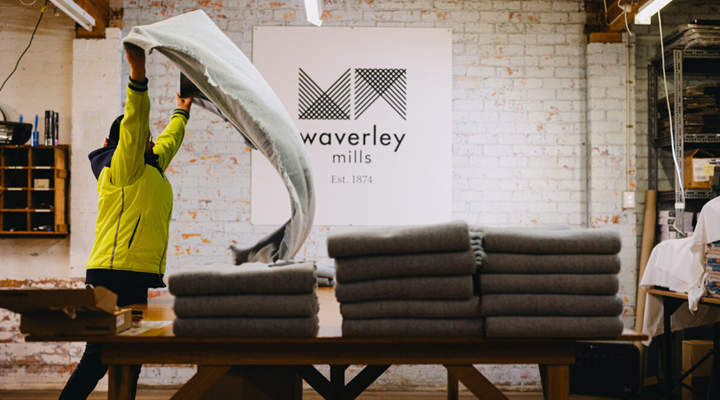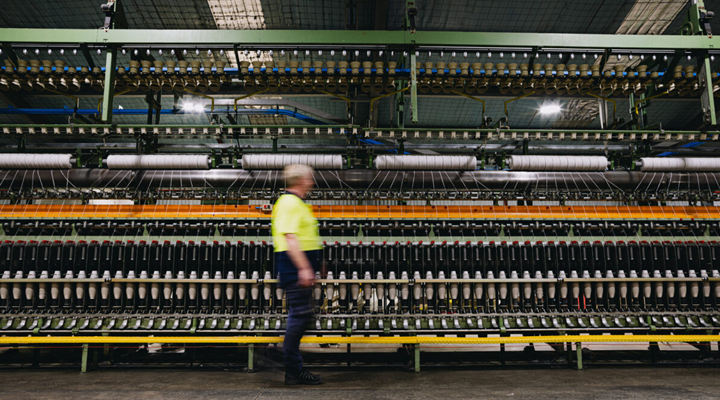Walking the windswept grounds of Waverley Mills on the outskirts of Launceston, Tasmania, it’s easy to imagine what Australia’s oldest working textile mill was like in its heyday. Founded in 1874 by Scotsman Peter Bulman on the banks of Distillery Creek, the mill once commanded 80 per cent of the Australian blanket market and employed more than 300 people to card, spin, dye, weave and finish a wide range of woollen products. At one time, the creek was used to clean the wool in it
in its raw form and to power the machines that turned the wool into yarn and eventually woven textiles.
While the mill’s workforce has shrunk considerably – it numbers 31 today – and its machines no longer run on hydroelectricity, in other ways, it hasn’t changed at all.
It still handles every aspect of the wool manufacturing and weaving process on-site. In fact, it’s the last remaining mill doing so in Australia, and ensuring its continued operation has been a key focus of its leadership team in recent years.
“First and foremost, we’re working on getting the mill operating financially sustainably as a mill. We’re the only one left. It’s quite a task, and we’re almost there,” David Giles-Kaye, Waverley Mills’ executive director, told Inside Retail.
Building brand partnerships
From a business model perspective, this has involved working with new brands to make products at the mill, such as its partnership with Country Road on a limited-edition picnic rug earlier this year, as well as reviving its own brand and direct-to-consumer sales.
One of Waverley Mills’ best-selling ranges is its recycled woollen throws, which are made with 30 per cent recycled wool from offcuts that otherwise would have gone to landfill.
Previously, the mill used a small amount of synthetic fibre in its recycled wool, but, after rebuilding its equipment, it was able to remove all the synthetic material without sacrificing the quality of the product.
“Getting that right has been really important to us, and the other thing is getting our story right,” Giles-Kaye said.
For him, this means highlighting the “inherent sustainability” of making products at Waverley Mills. Because the mill sources wool from nearby farms and turns the raw material into finished products entirely in-house, its supply chain is much shorter, less carbon-intensive and more traceable than most.
“We know exactly where we stand. We know all dyes we use are Oeko-Tek certified. We know how our wastewater is treated, but we need to have a document that says, ‘This is exactly what it is,’ so we’re still just piecing all that together,” he said.
Solving the skills shortage
Beyond launching new brand collaborations and expanding its product offerings, the mill has invested nearly A$10 million in upgrading its facilities and buying new machinery over the last few years. This includes a state-of-the-art winding machine that has improved both the efficiency and quality of the spinning process.
“We’ll start to really realise those production efficiencies, which is incredibly important as a manufacturer because you don’t get to say, ‘The yarn you supplied was no good,’ and send it back,” Giles-Kaye said. “You own it every step of the way. It gives you ultimate control over everything and ultimate responsibility over everything. So you have to have really good systems in place.”
A major challenge Waverley Mills continues to face, however, is the shortage of skilled labour. Like many countries that offshored their textile manufacturing in the 1990s, Australia lost a generation of workers who might otherwise have learned the trade in technical schools or through apprenticeships.
As more mills closed down, the pool of people with the knowledge to operate a carding machine, or tie on a warp, has diminished.
“Skills are a major problem for us,” Giles-Kaye acknowledged. “There’s almost no proper pathway into skilled operational roles in Australia. We’re actually trying to piece together an apprenticeship scheme with another company, particularly around our dyeing and some of our weaving, but all the other skills development we’ve done in-house.”
Solving this issue will be vital for Waverley Mills as it looks to scale up operations in the future. Giles-Kaye is eyeing international expansion in the next one to two years and longer-term, he is exploring opportunities to make the mill a tourist destination, with tours, a restaurant, and perhaps an event centre.
As he pointed out, Waverley Mills has been through many iterations over the past 150 years, surviving war times, depression, removal of trade barriers, the emergence of the synthetics industry and changing consumer preferences.
“Waverley Mills stands for resilience as much as for beautiful and enduring textiles and creativity,” he said.
“With this resilience, our new capability and our partnership with Tasmanian wool growers, this time marks our evolution into the next phase. Let’s see what this brings.”


